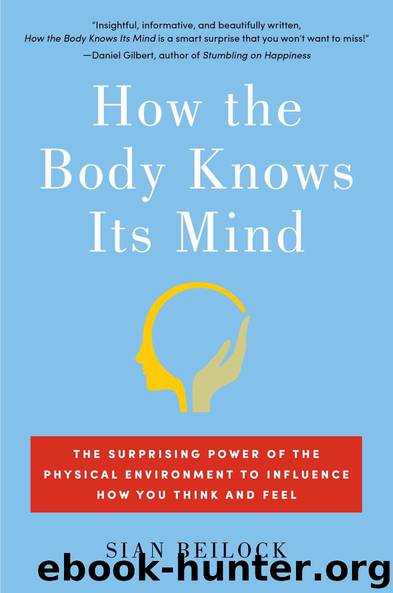How the Body Knows Its Mind: The Surprising Power of the Physical Environment to Influence How You Think and Feel by Sian Beilock

Author:Sian Beilock [Beilock, Sian]
Language: eng
Format: epub, mobi
Publisher: Atria Books
Published: 2015-01-06T00:00:00+00:00
CHAPTER 8
The Roots of Social Warmth
In 1957 at the University of Wisconsin Primate Laboratory run by the psychologist Harry Harlow, Jane, a tiny one-day-old rhesus monkey, was separated from her mother. In the wild, this sort of separation would mean almost certain death for the little monkey, but Jane would be taken care of by experienced animal laboratory technicians and be well-fed, warm, and clean. Jane was placed alone in a wire cage so that Harlow and his research team could study the nature of love.
The first signs of love and affection in humans are those between infants and their mother. Much of our ability to emotionally connect and empathize with others is thought to arise from this intimate connection. But what drives the love of an infant for her mother? How does this initial love for our mother translate into our ability as adults to show affection for a lover or a spouse?
In the 1940s and 1950s, when psychology was dominated by theories from psychoanalysis and behaviorism, the conventional wisdom was that the strong attachment between mother and infant was driven mostly by an infant’s most basic need: the need for food, primarily breast milk. Infants were thought to associate their mother with the reduction of hunger, and any feelings of love and affection toward the mother were considered byproducts of this association. Harlow wasn’t convinced of this view. He knew, thanks to Pavlov’s experiments with dogs, that almost anything can become positively associated with food. Every time Pavlov gave his dogs a steak, he would ring a bell. After a while, the dogs began to salivate at the sound of the bell, even when a steak was no longer part of the deal. Importantly, after an even longer while, the bell would stop triggering this salivation effect, and the link between the bell and the meat disappeared. This kind of association seems very different from the love between a mother and child. Even when our mother is no longer our primary provider, human affection doesn’t usually wane. If anything, it strengthens into a lifelong bond. This sort of affection is difficult to explain by the simple satisfaction of basic needs. Harlow wondered if affection in itself was important for healthy development, no less vital than food or water.
Harlow’s ideas were in stark contrast to a popular view of the time, that affection served no real purpose for human development. Parents were often warned that too much affection could lead to psychological issues, not help curb them. “When you are tempted to pet your child, remember that mother love is a dangerous instrument,” wrote John Watson, a leading psychologist of the day.1
Harlow was initially hired by the University of Wisconsin to study the conditions under which rats learn to navigate through mazes to get food, but the university was taking a long time giving him the space he needed to get his rodent work done. After hearing him complain over a dinner party about his nonexistent laboratory, one of his friends suggested he start working with monkeys instead.
Download
How the Body Knows Its Mind: The Surprising Power of the Physical Environment to Influence How You Think and Feel by Sian Beilock.mobi
This site does not store any files on its server. We only index and link to content provided by other sites. Please contact the content providers to delete copyright contents if any and email us, we'll remove relevant links or contents immediately.
The Art of Thinking Clearly by Rolf Dobelli(8835)
The 5 Love Languages: The Secret to Love That Lasts by Gary Chapman(8480)
Mindhunter: Inside the FBI's Elite Serial Crime Unit by John E. Douglas & Mark Olshaker(7826)
Becoming Supernatural by Dr. Joe Dispenza(7091)
Nudge - Improving Decisions about Health, Wealth, and Happiness by Thaler Sunstein(6628)
The Road Less Traveled by M. Scott Peck(6626)
Enlightenment Now: The Case for Reason, Science, Humanism, and Progress by Steven Pinker(6402)
Win Bigly by Scott Adams(6306)
Mastermind: How to Think Like Sherlock Holmes by Maria Konnikova(6220)
The Way of Zen by Alan W. Watts(5786)
Factfulness: Ten Reasons We're Wrong About the World – and Why Things Are Better Than You Think by Hans Rosling(4011)
The State of Affairs by Esther Perel(3917)
Gerald's Game by Stephen King(3913)
Man's Search for Meaning by Viktor Frankl(3620)
The Confidence Code by Katty Kay(3560)
Thinking in Bets by Annie Duke(3526)
The Worm at the Core by Sheldon Solomon(2910)
Enlightenment Now by Steven Pinker(2910)
Liar's Poker by Michael Lewis(2804)
